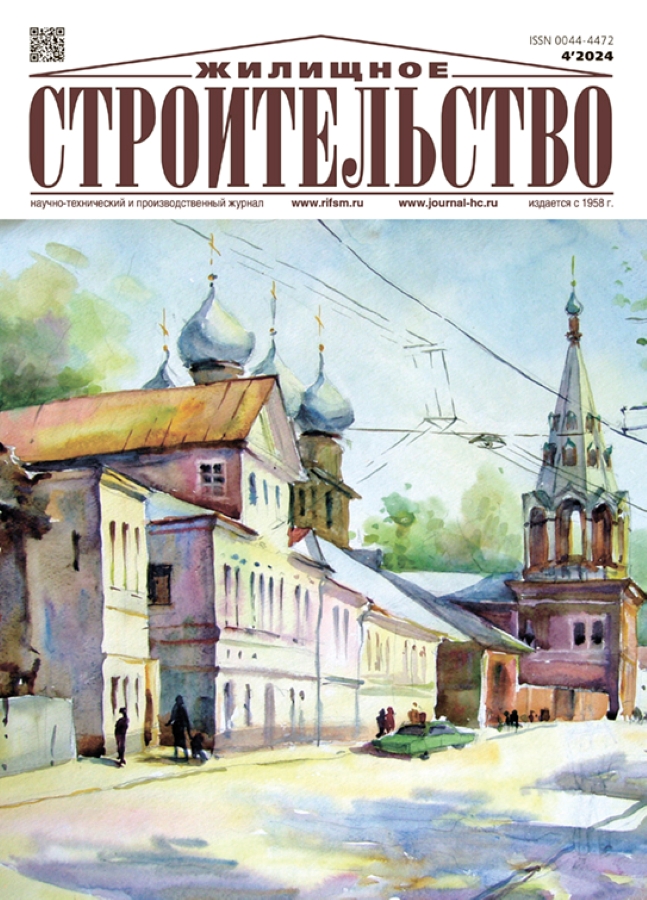Analysis of the Cost of Fuel and Energy Resources During the Overhaul of an Apartment Building
- 作者: Korol E.A.1, Zhuravleva А.А.1
-
隶属关系:
- National Research Moscow State University of Civil Engineering
- 期: 编号 4 (2024)
- 页面: 47-52
- 栏目: Articles
- URL: https://ter-arkhiv.ru/0044-4472/article/view/635889
- DOI: https://doi.org/10.31659/0044-4472-2024-4-47-52
- ID: 635889
如何引用文章
详细
The study presents tools for calculating the consumption of fuel and energy resources when carrying out major repairs of a multi-apartment residential building. The purpose of the study is to reduce energy consumption during the work phase and increase the efficiency of the capital construction project. The methodological approaches of the study are based on calculation, analysis and comparison of the obtained values of consumption of fuel and energy resources when carrying out major repairs of an apartment building. Based on the results of the study, it was established that the structure of energy costs during major repairs is determined to a greater extent by the «machinery and mechanisms» consumer group, which may include a different number of subgroups. Analysis of the calculated values of consumption of fuel and energy resources showed that significant energy consumption during repair work is due to the mechanization of labor using construction machines (truck crane, truck) and equipment (roof burner, combined sprayer, etc.).
全文:
作者简介
E. Korol
National Research Moscow State University of Civil Engineering
编辑信件的主要联系方式.
Email: KorolEA@mgsu.ru
Doctor of Sciences (Engineering), Professor, Head of the Department of Housing and Communal Services
俄罗斯联邦, MoscowА. Zhuravleva
National Research Moscow State University of Civil Engineering
Email: ZhuravlevaAA@mgsu.ru
Candidate of Sciences (Engineering), Senior Lecturer
俄罗斯联邦, Moscow参考
- Davidyuk A.A., Bukavtsov O.V., Deryavko R.M. Program for extending the life of residential buildings in Moscow. Analysis of practical experience: advantages and disadvantages. Zhilishchnoe stroitel’stvo [Housing Constructions]. 2018. No. 10, pp. 49–54. (In Russian).
- Migunov I.N. Assessment of the realization of a national project for improving housing conditions of the population. Zhilishchnoe Stroitel’stvo [Housing Construction]. 2020. No. 8, pp. 40–47. (In Russian). DOI: https://doi.org/10.31659/0044-4472-2020-8-40-47
- Korol’ E.A., Zhuravleva A.A., Petrosyan R.S. Determination of emissions of harmful substances during operation machines and mechanisms on the construction site. Promyshlennoe i grazhdanskoe stroitel’stvo. 2022. No. 8, pp. 57–61. (In Russian). doi: 10.33622/0869-7019.2022.08.57-61
- Korol’ E.A., Zhuravleva A.A. Impact of the work of energy consumers during the construction of low-rise residential buildings on the environment. Academia. Arkhitektura i stroitel’stvo. 2021. No. 3, pp. 108–114. (In Russian). doi: 10.22337/2077-9038-2021-3-108-114
- Shubin I.L., Umnyakova N.P., Matveeva I.V., Andrianov K.A. Quality of the building envelope is the basis for creating an environmentally friendly environment of vital activity. Zhilishchnoe Stroitel’stvo [Housing Construction]. 2019. No. 6, pp. 10–15. (In Russian). DOI: https://doi.org/10.31659/0044-4472-2019-6-10-15
- Sheina S.G., Umnyakova N.P., Fedyaeva P.V., Minenko E.N. The best European experience in implementing energy-saving technologies in the housing stock of the Russian Federation. Zhilishchnoe Stroitel’stvo [Housing Construction]. 2020. No. 6, pp. 29–34. (In Russian). DOI: https://doi.org/10.31659/0044-4472-2020-6-29-344
- Rimshin V.I., Shubin I.L., Erofeev V.T., Avetisyan A.A. Automation of the life cycle of buildings during reconstruction and major repairs. Zhilishchnoe Stroitel’stvo [Housing Construction]. 2022. No. 7, pp. 6–12. (In Russian). DOI: https://doi.org/10.31659/0044-4472-2022-7-6-12
- Shirazi M., Salimi M., Hosseinpour M. Improving sustainability of oil industry via integration with geothermal energy: analysis of strategies. Journal оf Energy Management and Technology (JEMT). 2024. Vol. 8, pp. 1–8. doi: 10.22109/JEMT.2023.365829.1410
- Olanrewaju O.A. Application of an integrated model to a construction and building industry for energy- saving assessment. South African Journal of Industrial Engineering. 2021. Vol. 32. No. 2, pp. 110–123. doi: 10.7166/32-2-2321
- Buchner K., Uhlig, J. Discussion on Energy Saving and Emission Reduction Technology of Heat Treatment Equipment. Berg Huettenmaenn Monatsh. 2023. Vol. 168, pp. 109–113 doi: 10.1007/s00501-023-01328-5
- Shen S. Application of Green Energy-Saving Technologies in Green Buildings in Real Estate Construction. Highlights in Science, Engineering and Technology. 2023. Vol. 79, pp. 45–50. doi: 10.54097/hset.v79i.15090
- Chen Y., Ma L., Zhu Z. The environmental-adjusted energy efficiency of China’s construction industry: a three-stage undesirable SBM-DEA model. Environ Sci Pollut Res. 2021. Vol. 28, pp. 58442–58455. (In Russian). doi: 10.1007/s11356-021-14728-2
- Korol’ E.A., Zhuravleva A.A. Determining the consumption of fuel and energy resources during mechanized work in low-rise construction. Vestnik MGSU. 2020. No. 5, pp. 712–728. (In Russian). doi: 10.22227/1997-0935.2020.5.712-728
补充文件











